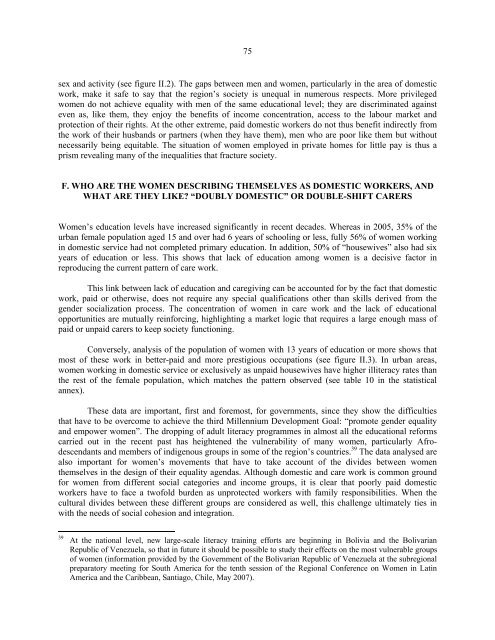Women in Latin America and the Caribbean - Cepal
Women in Latin America and the Caribbean - Cepal
Women in Latin America and the Caribbean - Cepal
You also want an ePaper? Increase the reach of your titles
YUMPU automatically turns print PDFs into web optimized ePapers that Google loves.
75<br />
sex <strong>and</strong> activity (see figure II.2). The gaps between men <strong>and</strong> women, particularly <strong>in</strong> <strong>the</strong> area of domestic<br />
work, make it safe to say that <strong>the</strong> region’s society is unequal <strong>in</strong> numerous respects. More privileged<br />
women do not achieve equality with men of <strong>the</strong> same educational level; <strong>the</strong>y are discrim<strong>in</strong>ated aga<strong>in</strong>st<br />
even as, like <strong>the</strong>m, <strong>the</strong>y enjoy <strong>the</strong> benefits of <strong>in</strong>come concentration, access to <strong>the</strong> labour market <strong>and</strong><br />
protection of <strong>the</strong>ir rights. At <strong>the</strong> o<strong>the</strong>r extreme, paid domestic workers do not thus benefit <strong>in</strong>directly from<br />
<strong>the</strong> work of <strong>the</strong>ir husb<strong>and</strong>s or partners (when <strong>the</strong>y have <strong>the</strong>m), men who are poor like <strong>the</strong>m but without<br />
necessarily be<strong>in</strong>g equitable. The situation of women employed <strong>in</strong> private homes for little pay is thus a<br />
prism reveal<strong>in</strong>g many of <strong>the</strong> <strong>in</strong>equalities that fracture society.<br />
F. WHO ARE THE WOMEN DESCRIBING THEMSELVES AS DOMESTIC WORKERS, AND<br />
WHAT ARE THEY LIKE “DOUBLY DOMESTIC” OR DOUBLE-SHIFT CARERS<br />
<strong>Women</strong>’s education levels have <strong>in</strong>creased significantly <strong>in</strong> recent decades. Whereas <strong>in</strong> 2005, 35% of <strong>the</strong><br />
urban female population aged 15 <strong>and</strong> over had 6 years of school<strong>in</strong>g or less, fully 56% of women work<strong>in</strong>g<br />
<strong>in</strong> domestic service had not completed primary education. In addition, 50% of “housewives” also had six<br />
years of education or less. This shows that lack of education among women is a decisive factor <strong>in</strong><br />
reproduc<strong>in</strong>g <strong>the</strong> current pattern of care work.<br />
This l<strong>in</strong>k between lack of education <strong>and</strong> caregiv<strong>in</strong>g can be accounted for by <strong>the</strong> fact that domestic<br />
work, paid or o<strong>the</strong>rwise, does not require any special qualifications o<strong>the</strong>r than skills derived from <strong>the</strong><br />
gender socialization process. The concentration of women <strong>in</strong> care work <strong>and</strong> <strong>the</strong> lack of educational<br />
opportunities are mutually re<strong>in</strong>forc<strong>in</strong>g, highlight<strong>in</strong>g a market logic that requires a large enough mass of<br />
paid or unpaid carers to keep society function<strong>in</strong>g.<br />
Conversely, analysis of <strong>the</strong> population of women with 13 years of education or more shows that<br />
most of <strong>the</strong>se work <strong>in</strong> better-paid <strong>and</strong> more prestigious occupations (see figure II.3). In urban areas,<br />
women work<strong>in</strong>g <strong>in</strong> domestic service or exclusively as unpaid housewives have higher illiteracy rates than<br />
<strong>the</strong> rest of <strong>the</strong> female population, which matches <strong>the</strong> pattern observed (see table 10 <strong>in</strong> <strong>the</strong> statistical<br />
annex).<br />
These data are important, first <strong>and</strong> foremost, for governments, s<strong>in</strong>ce <strong>the</strong>y show <strong>the</strong> difficulties<br />
that have to be overcome to achieve <strong>the</strong> third Millennium Development Goal: “promote gender equality<br />
<strong>and</strong> empower women”. The dropp<strong>in</strong>g of adult literacy programmes <strong>in</strong> almost all <strong>the</strong> educational reforms<br />
carried out <strong>in</strong> <strong>the</strong> recent past has heightened <strong>the</strong> vulnerability of many women, particularly Afrodescendants<br />
<strong>and</strong> members of <strong>in</strong>digenous groups <strong>in</strong> some of <strong>the</strong> region’s countries. 39 The data analysed are<br />
also important for women’s movements that have to take account of <strong>the</strong> divides between women<br />
<strong>the</strong>mselves <strong>in</strong> <strong>the</strong> design of <strong>the</strong>ir equality agendas. Although domestic <strong>and</strong> care work is common ground<br />
for women from different social categories <strong>and</strong> <strong>in</strong>come groups, it is clear that poorly paid domestic<br />
workers have to face a twofold burden as unprotected workers with family responsibilities. When <strong>the</strong><br />
cultural divides between <strong>the</strong>se different groups are considered as well, this challenge ultimately ties <strong>in</strong><br />
with <strong>the</strong> needs of social cohesion <strong>and</strong> <strong>in</strong>tegration.<br />
39<br />
At <strong>the</strong> national level, new large-scale literacy tra<strong>in</strong><strong>in</strong>g efforts are beg<strong>in</strong>n<strong>in</strong>g <strong>in</strong> Bolivia <strong>and</strong> <strong>the</strong> Bolivarian<br />
Republic of Venezuela, so that <strong>in</strong> future it should be possible to study <strong>the</strong>ir effects on <strong>the</strong> most vulnerable groups<br />
of women (<strong>in</strong>formation provided by <strong>the</strong> Government of <strong>the</strong> Bolivarian Republic of Venezuela at <strong>the</strong> subregional<br />
preparatory meet<strong>in</strong>g for South <strong>America</strong> for <strong>the</strong> tenth session of <strong>the</strong> Regional Conference on <strong>Women</strong> <strong>in</strong> Lat<strong>in</strong><br />
<strong>America</strong> <strong>and</strong> <strong>the</strong> <strong>Caribbean</strong>, Santiago, Chile, May 2007).











